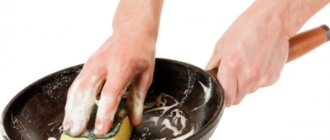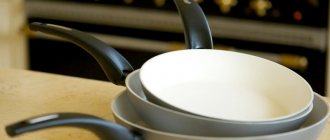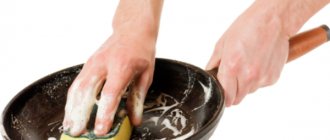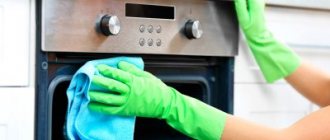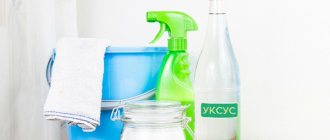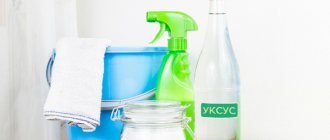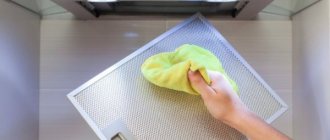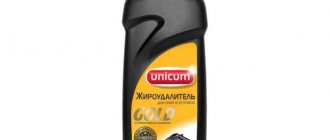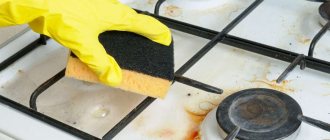/Order/
To be honest, cleaning a frying pan from carbon deposits and grease can often be very difficult, especially if it is old or badly burnt. But there is good news: you can still deal with most persistent stains with cheap products that you already have at home (or at least make the task significantly easier). The main thing is to choose the method that is suitable for your frying pan. After all, what a cast-iron saucepan will save, a Teflon pancake maker can hopelessly destroy.
In this article you can find almost all traditional and non-standard methods of cleaning frying pans of any type: cast iron, stainless steel, aluminum with non-stick coating (Teflon, enamel, ceramic, marble) and without it. Just choose the recipe that suits you.
How to choose a method for cleaning a frying pan
To properly clean an old frying pan from carbon deposits, first of all, determine what material it is made of. There are cast iron, aluminum and stainless steel frying pans.
In modern industry, cookware with non-stick coating is gaining increasing popularity. She requires careful and delicate care. Such pans are easy to clean, as their surface protects against the formation of carbon deposits on the dishes.
Causes of burning
Regardless of the material from which the frying pan is made, there are several main reasons for its deterioration:
- low-quality frying pans - samples from trusted companies that have a non-stick coating, according to the manufacturer's recommendation, can be used for no more than 2-4 years. What can we say about fakes or cheap dishes? When consumers try to save money by buying frying pans at extremely low prices, they do not realize that their useful life is reduced significantly. Thus, a cheaply purchased non-stick frying pan will only be good for 2-3 months. After approximately this period of time, food begins to stick;
- Improper use of the frying pan also causes mechanical damage to its surface. Whether the cookware is ceramic, Teflon coated, cast iron or any other material, it cannot withstand abuse. It is important to follow the recommendations for use given by the manufacturer or read on the Internet, otherwise the dishes will soon become unusable.
To eliminate the causes of food burning in a frying pan, you should choose only high-quality samples and follow the rules for use, care and storage.
Traditional methods against soot in a frying pan
At home, you can use improvised means that are always available in the kitchen. They safely allow you to clean the inside of the frying pan from carbon deposits.
The prepared table will help determine contraindications for using a particular cleaning product for a specific type of frying pan.
Citric acid, vinegar and washing powder
The method involves use with different approaches.
- When the deposits on the dishes are fresh enough, lemon will do its job perfectly. To do this, you need to place the frying pan in the solution (for 1 liter of water - 1 tablespoon of citric acid). Boil for 20-30 minutes. Rinse with warm water.
- You can add vinegar to the prepared solution. Boil the frying pan in this water for 10-15 minutes. Turn off the heat and clean the dishes with a sponge after 2 hours. Then you can add washing powder to the same composition, bring to a boil, and leave for another 1 hour. Rinse with warm water.
- If there are damages and scratches on the frying pan, it is better not to boil the dishes. After each time of use, it is enough to wipe with a sponge soaked in a weak solution of acetic acid.
Important! The method cannot be used to clean aluminum pans, as well as dishes with damaged coating.
Coca Cola
The carbonated drink has long established itself as an excellent means for cleaning pots and pans. Just pour Coca-Cola into a bowl, bring to a boil and after 15 minutes turn off the stove. Leave it like this until it cools completely.
Important! The method is ideal for cleaning cast iron and stainless steel cookware.
Mustard powder
In Soviet times, mustard was valued as the most effective means of removing fat. To do this, a frying pan or saucepan was heated over a fire. They covered the bottom with mustard powder and scrubbed it off. After 20 minutes, wash off with water.
If it was not possible to wash it the first time, then the dishes were soaked in mustard solution for 40 minutes. Then washed again.
Cleaning and boiling in salt solution
Cleaning with salt is suitable for almost any dishware.
- Salt is poured onto the bottom of the frying pan (can be used together with sand).
- Lightly moisten and let stand for at least 2 hours. Sponge.
- If this does not help, you must immediately add water and boil. Perhaps this option will be more effective.
For your information! Do not apply to Teflon and ceramic cookware.
Using hydrogen peroxide, baking soda or soda ash
- Baking soda will help clean the pan from years of carbon deposits. Place a frying pan in a container with boiling water and soda. Reduce the heat to low and leave for 30 minutes. Then turn it off. Let it sit for another half hour. The dishes are washed with warm water.
- If this method does not help, add hydrogen peroxide and a few drops of dishwashing detergent to the soda solution. Leave for another 30-45 minutes. Rinse thoroughly with water several times. The method is actively used for cleaning non-stick frying pans.
Another option (always effective) is when glue and soap are added to the soda solution (see recipe above).
Ammonia and borax for cleaning cast iron surfaces
If food is badly burnt, the prepared solution will help to cope with the soot.
- For 300 ml of water, take ammonia and 12 g of borax.
- This mixture is poured onto the burnt surface.
- After 1 hour, the liquid is drained, the carbon deposits should easily come away from the surface.
- Kitchen utensils are washed and wiped.
How and with what to wash old carbon deposits and grease
Fill the pan with 5 liters of water. Add 200 g of baking soda and 2 bottles of liquid glass to it. Place the container on the stove and heat the liquid to maximum. Then submerge the pan in it. Continue heat treatment for 60-90 minutes. Then wait until the composition cools down. Remove the pan from it and wash it as usual.
When carrying out work, do not forget about safety measures. Wear gloves and a respirator to protect your hands and respiratory system from chemicals. Provide drafts in the room.
You can remove old carbon deposits using mustard powder. Pour 250 g of product into a frying pan and pour 1 liter of boiling water. Cover it all with a lid and leave for a day. Then remove dirt with a soft sponge. By the way, you can wash any dishes with mustard on an ongoing basis. This is how our grandmothers often used it. It not only degreases, but also has a powerful bactericidal effect. It is as effective as modern chemicals.
Another method of solving the problem suggests using 9% vinegar. Combine it with water in a ratio of 1:4 and pour into the frying pan. Place the dishes on the stove, wait for the liquid to boil and keep the frying pan on low heat for 2-3 hours. Then pour the vinegar solution into the sink and use a sponge. To prevent the container from having an unpleasant odor after the procedure, boil clean water in it 2-3 times with the addition of lemon (lime) or fresh apple juice.
Baking powder will help get rid of the problem without any risks. Pour a packet of baking powder into the pan. Then pour water to the top. Place the utensils on the stove, bring the liquid to 100 °C and boil for 15 minutes. After this, let it cool and drain. Wash the pan as usual.
Removing carbon deposits from a frying pan using household chemicals
It is advisable to choose a dish cleaning product that does not contain abrasive substances. It is better to use household chemicals to clean the outside of the frying pan. To clean the inside of the dishes, it is safer to use folk remedies.
- Schumannite is one of the most powerful grease cleaners. Contains alkali. Copes with even the most stubborn stains on cast iron, enameled and metal products.
- "DazhBo" is a washing liquid suitable for cleaning any surface.
- "Easywork" - copes well with any dirt.
- "Unicum" is a universal cream for cleaning dishes. It has a pungent odor, but is capable of cleaning even the most multi-layered deposits in 2 minutes.
- Frosch is a plant-based cleaner. Has a convenient sprayer. It is in great demand among housewives.
The use of any chemical means compliance with safety measures. Therefore, before you start cleaning dishes with a chemical composition, you must wear rubber gloves. If the procedure is carried out at home, you should open a window or vent in the kitchen.
What means will we use?
Cleaning frying pans from carbon deposits involves the use of improvised means, household chemicals and special compounds.
The effectiveness of traditional cleaning methods has been tested by many generations of housewives. Their action is based on the use of substances that can be found in any home: salt, vinegar and soda, citric acid, activated carbon, boric acid, hydrogen peroxide, sunflower oil, etc. These are cheap, harmless substances for cleaning burnt marks.
Household chemicals are also found in almost every home. These are glue, laundry soap, laundry detergents, and dishwashing detergents. Together with home methods, they will help clean the dirtiest frying pan from grease and soot.
Industrial anti-burn agents are more expensive than household chemicals and improvised substances. Their composition is toxic. If used improperly, they can harm human health. But they give effect in the most hopeless cases.
Recommendations from experts
Manufacturers of cookware recommend adhering to rules that help extend the life of the frying pan. It is important to follow preventive measures that prevent further contamination.
- When cooking and stirring food in a frying pan, you must use a wooden or plastic spatula.
- Use cleaning powders, scratching sponges, and scrapers as little as possible. This will prevent scratches on the inside of the pan.
- If the frying pan is often washed in the dishwasher, then you must clean it by hand once a month. In this case, you can easily notice the appearance of soot, which can be easily eliminated at the initial stage of its manifestation.
- Melamine sponges are well suited for cleaning ceramic products and enamel dishes. But they can only clean the outside.
- An aluminum frying pan should never be rubbed with an iron sponge. The damaged surface quickly oxidizes and the oxide gets into the food. Which will negatively affect human health.
- Baking soda or coarse salt helps get rid of rust on an old frying pan. After washing, be sure to heat the dishes so that the food does not burn.
Sprays
Special products are sold not only in the form of liquids in bottles and cans, but also in the form of sprays.
Spray for removing soot and grease
The grease cleaner is sold in a special container with a convenient spray nozzle, which allows you to economically and evenly apply the liquid to the surface of the container. This can make it much more economical to mop up grease from the pan with a spray.
General rules
Before you begin the cleaning procedure for a frying pan, you first need to determine what it is made of in order to choose the right cleaning method.
- Cast iron frying pans, although heavy in weight, are still very popular, since food turns out much tastier on them than on aluminum or ceramic ones.
- Teflon ones are non-stick and easy to clean, but over several years of use they gradually become covered with a coating that is difficult to wash off.
- Ceramic ones require special care and cannot be cleaned with every household product.
- Titanium is the most durable, easily withstands sudden temperature changes and does not break when dropped from a high height. They can be cleaned with any chemical means.
To prevent indelible dirt from accumulating on the surface of the frying pan, it must be washed immediately after cooking, without putting it off until tomorrow, otherwise it will be much more difficult to wash it.
Vinegar
Suitable for materials: aluminum, enamel, ceramics, cast iron, stainless steel.
Type of burnt product: jam, sugar, porridge, milk.
See also: How to cook corn
Instructions:
- Pour table vinegar over the contaminated areas.
- Cover and let stand for 1.5-2 hours.
- Clean using traditional methods.
Instead of vinegar, use citric acid or freshly squeezed lemon juice, but their effect will be less pronounced. This method also helps well against dark carbon deposits on the outside.
Activated carbon
Activated carbon is another folk remedy that can cleanse the inside and outside of fresh and old clots of fat.
Activated carbon
The pan is soaked in water, a large amount of active carbon is applied to the oil surface, after which the pan is left for a long period of time.
It is advisable to leave the pan with activated carbon overnight.
Prevention
It is easier to protect the frying pan than to subsequently remove a thick layer of carbon deposits. To make your dishes shine, follow these simple rules:
- Do not overheat an empty pan.
- Clean pans immediately after cooking.
- Regularly (once every 7-10 days) remove fat from the outside - removing a thin layer is easier than old growths.
- Use only delicate (wooden, silicone, plastic) spatulas, do not scratch with metal spoons or knives.
Important! The coating of cast iron cookware should be renewed from time to time. To do this, wash the frying pan thoroughly and grease it on all sides with sunflower oil. “Bake” in the oven at 200 degrees for 60 minutes and then let cool. Rinse with hot water.
Modern means and proven tricks of housewives allow you to remove carbon deposits from a frying pan in a matter of hours. But to enjoy cooking every day, take care of the cleanliness of your kitchen utensils regularly.
